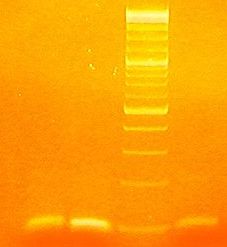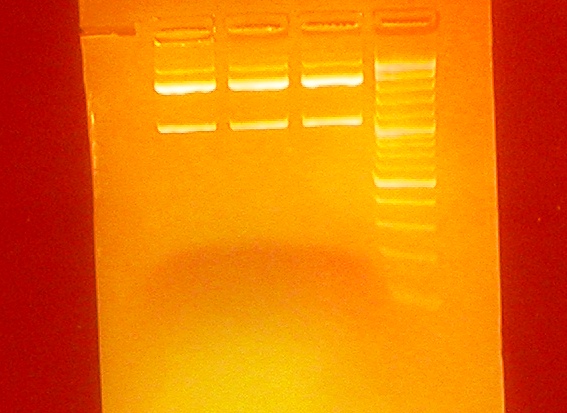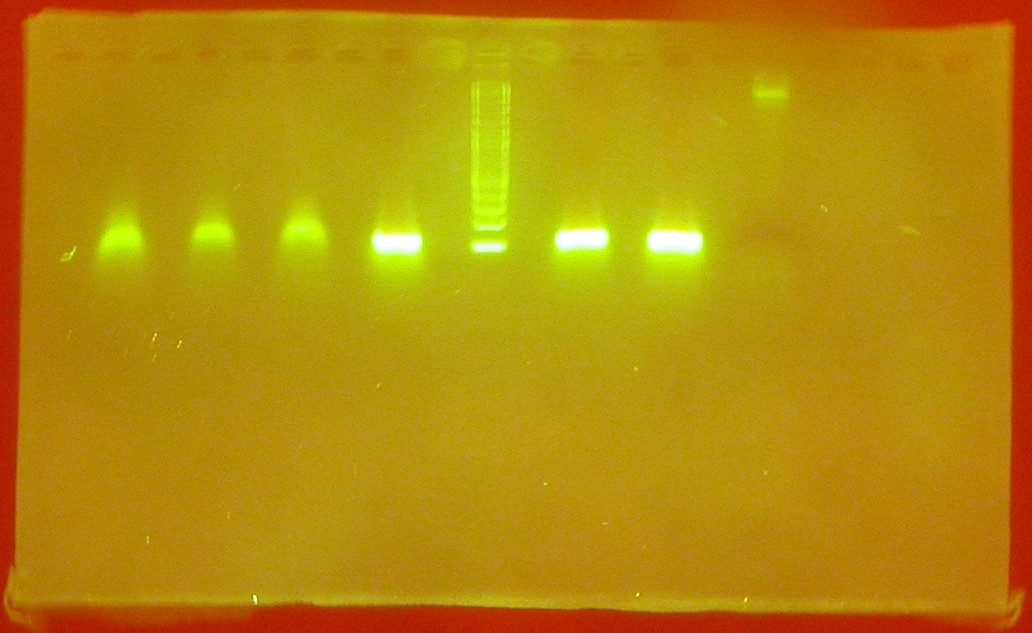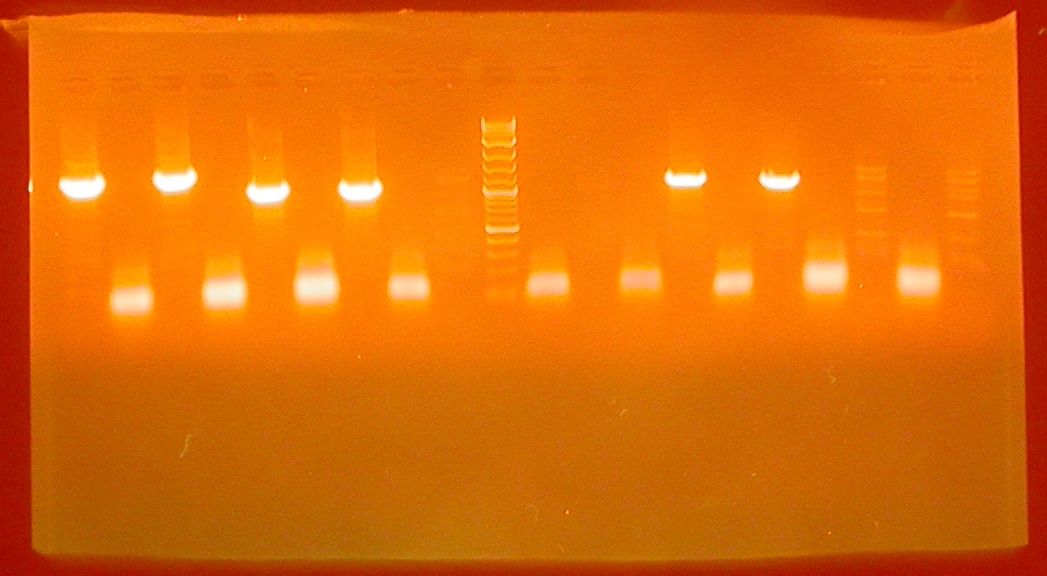Team:Bologna/Lab-Notebook
From 2009.igem.org
| HOME | TEAM | PROJECT | SOFTWARE | MODELING | WET LAB | PARTS | HUMAN PRACTICE | JUDGING CRITERIA |
|---|
Week 1: from 07/20/09 to 07/24/09
In order to realize our projects, we started looking for stardard plasmids. We needed one high and one low to medium copy number vectors, with different antibiotic resistence (A & K). We searched the Registry and we decided two possible combinations: PSB1K3 with PSB4A3 or PSB1A2 with PSB3K3.
Trasfomation of:
- PSB1K3 -> from 2009 kit, with BBa_J04450
- PSB3K3 -> from 2009 kit, with BBa_J04450
- PSB1A2 -> with BBa_J23100 and BBa_J04031
- PSB4A3 -> with BBa_J04500 and BBa_J04031
using Top10 chemically competent cells.
Since neither PSB1K3 nor PSB3K3 yielded colonies we tried another transformation, choosing different kit wells.
Trasfomation of:
- PSB1K3 -> from 2009 kit, with BBa_P1010
- PSB3K3 -> from 2009 kit, with BBa_P1010
- PSB3K3 -> from 2007 kit, with BBa_P1010
using DB3.1 chemically competent cells.
Only PSB3K3 from 2007 kit worked correctly. We decided to use PSB1A2 as high and PSB3K3 as low to medium copy number as they revealed right MW bands when checked with agarose gel. In the meantime, we requested another PSB1K3 with BBa_P1010 from Registry.
Week 2: from 07/27/09 to 07/31/09
- Sequences suspension to have 100 μM conc. (EP digestion and trasformation in a HCN plasmid with AMP)
| DNA sequences | Plasmid |
|---|---|
| H2O mQ == 4.5 μM | H2O mQ == 19.5 μM |
| Sequence == 20 μM | DNA (miniprep) == 5 μM |
| Buffer == 3 μM | Buffer == 3 μM |
| BSA == 0.5 μM | BSA == 0.5 μM |
| EcoRI enzyme == 1 μM | EcoRI enzyme == 1 μM |
| Pst1 enzyme == 1 μM | Pst1 enzyme == 1 μM |
| TOT: 30 μM | TOT: 30 μM |
Gel Run:
1.CIS
2.TRANS 4
3.MARKER
4.TRANS 7
5.PSB1A2
Week 3: from 08/3/09 to 08/7/09
- Amplification of CIS, TRANS 4 and TRANS 7 using PSB1A2. Inoculation and digestion.
- Unexpeted results from the gel run in all three sequences (3000, 2200, 1000 bp instead of 2100, 2000, 100 bp):
- Done the ligation again whit the same bad results.
- Done some test fluorescence measurements using GFP in plasmids with different copy number.
Week 4: from 08/10/09 to 08/14/09
HOLIDAY!!!
Week 5: from 08/17/09 to 08/21/09
- Done again the amplifications of CIS, TRANS 4 and TRANS 7 using PSB1A2 to undestand which is the problem we have had during the third week. Achieved the same wrong results.
- We decided to sequence the 1000 bp strand to understand what it really is. We sent our material to the Bmr-genomics in Padova for the dna sequencing.
Week 6: from 08/24/09 to 08/28/09
Bad news for our team:
- Re-Annealing of our sequences and after have done the PRC-Colony we discovered that the colonies were green. Probably due to a GFP contamination. The DNA sequencing coming from Padova confirmed our theory: in the 1000 bp strand there was the presence of GFP protein and no sign of our CIS or Trans sequences.
Week 7: from 08/31/09 to 09/04/09
- Done some experiments (trasformation and digestion with the same plasmid, PSB1A2, using different concentration of annealed) to confirm the Gfp contamination. All the gel runs have a 1000 bp strand.
- Investigation to discover where is the contamination.
- Starting use a new plasmid: PSB4A3. Trasfomation and digestion with the CIS sequence. From the gel run came out a 400 bp insert that could be correct (CIS+Primer=100bp+270bp=370bp):
- The same attempt with TRANS 4 and TRANS 7 didn't give us any concrete results.
Week 8: from 09/07/09 to 09/11/09
- Primers of our sequences arrived, so we amplified CIS-repressing and TRANS-repressor with a PCR. We designed primers so that they have the same sequence of the standard prefix and suffix.
- Gel run of results of PCR using a stain named GelStar that can detect smaller strains of DNA
- We assumed that some of our ligation problems may be caused by the low enzymes efficiency because of the restriction sites were too near to the extremities of our sequeces. For that reason we decided to order longer primers in order to make our sequences longer and solve problems with enzymes.
- Starting work with the operator Ox, developed by the 2008 Bologna Igem Team
Week 9: from 09/14/09 to 09/18/09
- Primers arrived, so we can use them to make our sequences longer.
- The operator OX was mounted on a standard plasmid.
- Tried a ligation with a plasmid containing the cell death gene, without positive results.
Week 10: from 09/21/09 to 09/25/09
- Performed other tests with CIS-repressing and TRANS-repressor.
- DNA-sequencing of the circuit with the operator OX, our first new BioBrick.
Week 11: from 09/28/09 to 10/02/09
- Ligation and mini-prep of the operator Ox, upstream of the protein GFP, under the control of the promoter J23118
- Digestion and ligation of Cis-repressing and Trans-repressor using the restriction enzymes SpeI and XbaI.
- Control digestion and Gel run; bur this test gave out only a strain, may be due to digestion problems.
Week 12: from 10/05/09 to 10/09/09
- Performed other tests mainly for perform fluorescence measures.
- Preparation of our BioBricks for the shipment.
 "
"





